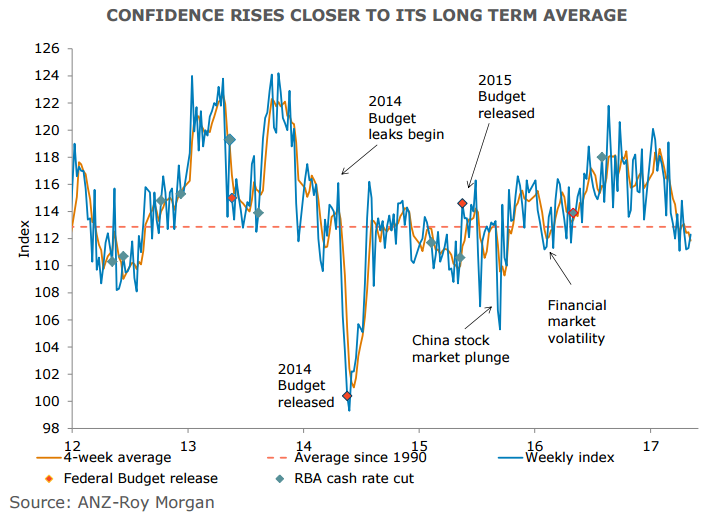Australia's consumer confidence ticked up a modest 0.9 percent in the week ending 7 May, data released earlier today showed. The index edged higher to 112.3 – just below its long term average. Households’ near and long term economic outlook posted solid increases of 5.0 percent and 4.9 percent respectively.
Confidence around current finances fell 3.3 percent erasing previous week's 2.6 percent rise. Meanwhile, views about future finances rose a modest 1.2 percent, partially reversing its previous 3.6 percent fall. The ‘good time to buy a household item’ fell 1.7 percent to its lowest level since early 2016. While the weekly measure of inflation expectations ticked down to 4.4 percent from 4.6 percent last week, the four week moving average remains unchanged.
“The stabilisation in consumer confidence after a period of trend decline is encouraging, albeit at levels below the long term average. This stabilisation may be a sign of an improving labour market. ANZ Job Ads and other business surveys point to further gains in employment in coming months, following on from the strong result in March," said ANZ in a report.
Retail sales disappointed in both March and Q1, with soft volumes and weak retail inflation. Retail sales unexpectedly fell for the second consecutive month, with nominal sales falling 0.1 percent in March, from a downwardly revised February. Real quarterly retail sales were also below consensus expectations, up just 0.1 percent q/q (from a downwardly revised 0.7 percent q/q in Q4 2016), setting up a weak base for Q1 GDP.
Consumption which accounts for 60 percent of Australia's economy is closely watched by the Reserve Bank of Australia (RBA). The recent speech by RBA Governor Lowe highlighted the Bank’s growing concern about the vulnerability of the economy to shocks to the household sector given the high level of indebtedness. ANZ noted that soft retail sales data is consistent with the earlier research that the household saving rate is likely to have risen in Q1.
In Prime Minister Malcolm Turnbull's first budget after being re-elected on a tiny majority last year saw the government has found money for infrastructure, removed AUD13bn of “zombie” policy measures and tinkered with housing affordability. The underlying cash balance is estimated to be –AUD29.4bn (-1.6percent of GDP) in 2017-18. The deficit is projected to shrink in each of the following three years and be broadly in balance in 2020-21.
Aussie dumped across the board after retail sales miss. Housing market concerns and the weakness in the commodity prices likely to keep downside pressure. AUD/USD hit fresh 4-month lows at 0.7328, but has recovered some losses to currently trade at 0.7355. Technical studies are bearish. We see scope for further downside. The pair has broken below 61.8% Fib retrace of 0.7160 to 0.7749 rally and is on track to test 78.6% Fib at 0.7286.
FxWirePro's Hourly AUD Spot Index was at 1.1415 (Neutral), while Hourly USD Spot Index was at 95.2758 (Bullish) at 1150 GMT. For more details on FxWirePro's Currency Strength Index, visit http://www.fxwirepro.com/currencyindex.



 Asian Stocks Edge Higher as Tech Recovers, U.S. Economic Uncertainty Caps Gains
Asian Stocks Edge Higher as Tech Recovers, U.S. Economic Uncertainty Caps Gains  Austan Goolsbee Signals Potential for More Fed Rate Cuts as Inflation Shows Improvement
Austan Goolsbee Signals Potential for More Fed Rate Cuts as Inflation Shows Improvement  Evercore Reaffirms Alphabet’s Search Dominance as AI Competition Intensifies
Evercore Reaffirms Alphabet’s Search Dominance as AI Competition Intensifies  New Zealand Business Confidence Hits 30-Year High as Economic Outlook Improves
New Zealand Business Confidence Hits 30-Year High as Economic Outlook Improves  U.S. Stock Futures Slip After CPI-Fueled Rally as Markets Weigh Economic Uncertainty
U.S. Stock Futures Slip After CPI-Fueled Rally as Markets Weigh Economic Uncertainty  Gold and Silver Surge as Safe Haven Demand Rises on U.S. Economic Uncertainty
Gold and Silver Surge as Safe Haven Demand Rises on U.S. Economic Uncertainty  RBA Unlikely to Cut Interest Rates in 2026 as Inflation Pressures Persist, Says Westpac
RBA Unlikely to Cut Interest Rates in 2026 as Inflation Pressures Persist, Says Westpac  Yen Near Lows as Markets Await Bank of Japan Rate Decision, Euro Slips After ECB Signals Caution
Yen Near Lows as Markets Await Bank of Japan Rate Decision, Euro Slips After ECB Signals Caution  Dollar Holds Firm Ahead of Global Central Bank Decisions as Yen, Sterling and Euro React
Dollar Holds Firm Ahead of Global Central Bank Decisions as Yen, Sterling and Euro React  Canada Signals Delay in US Tariff Deal as Talks Shift to USMCA Review
Canada Signals Delay in US Tariff Deal as Talks Shift to USMCA Review  Asian Currencies Slip as Dollar Strengthens; Indian Rupee Rebounds on Intervention Hopes
Asian Currencies Slip as Dollar Strengthens; Indian Rupee Rebounds on Intervention Hopes 































